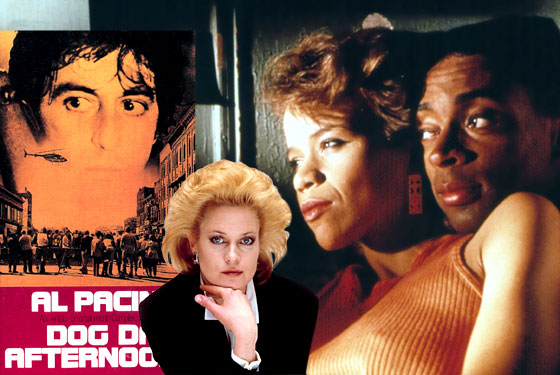
Close your eyes and the images leap out at you like those too-effusive sailors off the gangplank in On the Town: New York, New York, a hell of a film set. But in the city with the most subcultures, what could possibly be christened the New York movie, the one that inspires millions to cry, “That’s my town!”?
The city would have to be a character and a canvas: a wellspring, a goad, a source of liberation or its opposite, a snare. It would hinge on ambition or the hopelessness signaled by its lack. It would look like a melting pot in which nothing entirely melts. Its story would play out in public with a shot of showbiz razzmatazz. It would be crowded.
It would also be here. The classics, the ones that gave us so many archetypes—42nd Street, Mr. Deeds Goes to Town—were Hollywood affairs with soundstages and rear-screen projections. The New York with texture came later, in the back alleys of urban noirs or the gin mills of lost-weekend melodramas. Then came the ethnic Method types, with Brando on the waterfront (shot in Jersey, alas) and Borgnine’s Marty the bachelor butcher—a prole poet—saying, “I dunno, what do you wanna do” to his pal. In the high-rises, meanwhile, The Apartment turned on (bad) social mores and all-controlling real estate.
The late sixties and seventies brought Jon Voight’s hustling Midnight Cowboy in a world of grotesques, Gene Hackman’s Popeye Doyle careening under the train tracks and leaning on his horn, and blaxploitation heroes like Richard Roundtree’s Shaft giving some of us our first sight and earful of Harlem’s violent new mythology. A writer for this magazine fabricated a Bay Ridge disco scene—and the world fell so hard for John Travolta that it became real.
What, then, is the New York film? So many candidates. The best, The Godfather and its first sequel, combined to form a national epic. Other great movies are limited by their subcultures: the seminal comedies of Woody Allen with their hiply self-aware Jews; Martin Scorsese’s Italian fever-dreams; Spike Lee’s clay-oven Bed-Stuy in Do the Right Thing. Wall Street and Working Girl evoked the greedhead eighties ethos but didn’t cut very deep.
When I close my eyes, two films swim into my mind: Sweet Smell of Success and Dog Day Afternoon. The first captures a lurid, neon-lit metropolis of jazz joints and ‘21’ and tabloid chicanery set to Elmer Bernstein’s screaming brass. Here is Burt Lancaster’s Walter Winchell stand-in, who purrs through his big choppers, “I love this dirty town.”
Yet I finally settle on Sidney Lumet’s Dog Day Afternoon, based on a real, disastrous Brooklyn bank robbery, which mingles bad vibes from too much closeness with a profound human longing for community. Amid crowd scenes cut (by editor Dede Allen) with incomparable edginess, there is a middle section of such quiet intimacy that the whole crazy paradox of acting, of being private in public, becomes a metaphor for life in the big city. Al Pacino has played more great New York characters than anyone: Michael Corleone, Serpico, Carlito, the mayor, Satan as a corporate lawyer. Yet he has never been more soulful than as Sonny, depressive and manic, turned on by performing for cheering crowds and crushed by their abandonment, trying to reconcile what cannot be reconciled. He is New York’s most haunted mascot in its most haunting film.
